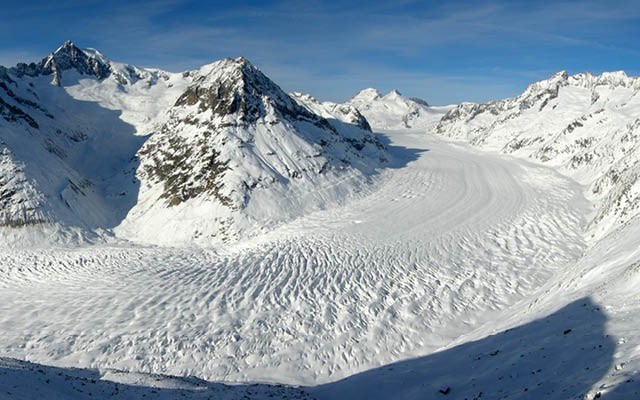The Swiss were smiling. These usually circumspect folk were suddenly lit up, one and all, by two days of snowfall in Crans-Montana. And it wasn't just children playing in their yards with winter toys yet to be used by the middle of January, but bakers, bus drivers, hairdressers and even the curmudgeonly ticket-taker at the funicular. When I mention to the owner of the Art de Vivre Hotel that everyone in town seems strangely animated, her face ignites. "Yes, of course" she beams. "The snow... it makes things beautiful. And this is what everyone loves, what everyone comes for."
The essence of winter in the mountains remained universal.
Crans-Montana, of course, is a venerable and storied resort, known both for it's sun-soaked glamour (300 days a year) and women's World Cup speed events. But it had suffered almost two months without snow, including the critical Christmas vacation period. Which made it not only critical when snow finally arrived (never mind that its unanchored mass was avalanching with unusual abandon onto the pistes) but ironic given that underway in town was the first European Mountain Travel Summit (EMTS), featuring abundant hand-wringing over not just the future of this vital tourism sector, but the climate-failing present as well. EMTS was a global leadership forum that brought together some 200 senior executives from the global mountain travel industry for two days of networking and learning. Presentations included the latest in critical market research and strategic planning focused on best practices and trends in the mountain travel industry. What were they finding out?
Well, for instance, how today's connected traveller has a high expectation of seamless travel influenced by experiences with players such as Uber, and that despite progress in planning and booking, the destination user experience was, in many places, still fragmented and unsupported by digital. They were learning what mountain destinations might glean from trends in adventure travel; about how Argentina's Bariloche ski area overcame the challenges of a natural disaster (volcanic explosion in nearby Chile) to regain its position as a leading international destination; what the Destination Marketing Organization of 2025 would look like; and how destinations were using virtual reality experiences in promotion. There were forward-thinking panel discussions with reps from the Expedia group, Ski.com, and Airbnb (unlike Whistler, no bashing) on reaching the destination traveller of today and tomorrow, and on the fast-growing Asian Pacific marketplace, with Chinese, Korean, and Japanese travel-industry types discussing the experiences their skiers sought. Oh, and there was data — so much freakin' data.
Once the Alps have been flocked in snow, however, attendees wasted no time in ditching the data to lay siege to the slopes, the increasing number of tracks outside directly proportional to those bailing on the sessions inside — including myself. The essence of a ski vacation remained universal.
Crans is a large area, it's upper reaches accessed by the usual improbable lift to a summit where the view takes in 18 4,000-metre peaks. I was staring — simultaneously no less — at the Weishorn and Matterhorn, Grandes Jorasses and Mont Blanc, laid out like rock wainscoting across the horizon. But I also knew that there was trouble in these panoramas, or at least behind them, and I would view it up close a few days later in the form of the Aletsch Glacier.
The Aletsch, largest glacier in continental Europe, is 23 kilometres long and 900 metres thick at its deepest. That's a lot of ice. If the entire thing melted right now it would provide everyone on Earth with a litre of water a day for 4.5 years. That's not going to happen, but if it continues melting at current rates — losing 10m per year in depth and 50 to 60m in length a year— it will be completely gone in 90 years. That would be a huge blow to Switzerland, whose voluminous tourism centred on the Aletsch includes observation platforms like the Eggishorn at Fiescheralp, and the famous Jungfrau railway spiralling up through the Eiger to overlook the glacier's upper cirque. With the Aletsch and its environs a UNESCO World Heritage region, the World Nature Centre in the town of Naters is dedicated to understanding its history and importance. But what I expect to be a typically sombre exhibition is actually one of the best museums I've ever been to, with interactive displays like a light-activated sandbox where you can build a volcano, raise a ridge, create a water-catchment basin and other miracles just by pushing the sand around. Wave your hand over the finished product and it shows where clouds will form, where precipitation will fall, even where glaciers might form. What better way to learn about the interaction of geology and the atmosphere than to make your own versions of both? What better way to value it?
As I left, laughing kids carried on a snowball fight on the streets outside the museum under a grey sky. Hopefully the snow would keep falling, the stone-faced Swiss would keep smiling, and mountain travel of the future wouldn't involve building your own and imagining what they were once like.
Leslie Anthony is a Whistler-based author, editor, biologist and bon vivant who has never met a mountain he didn't like.




